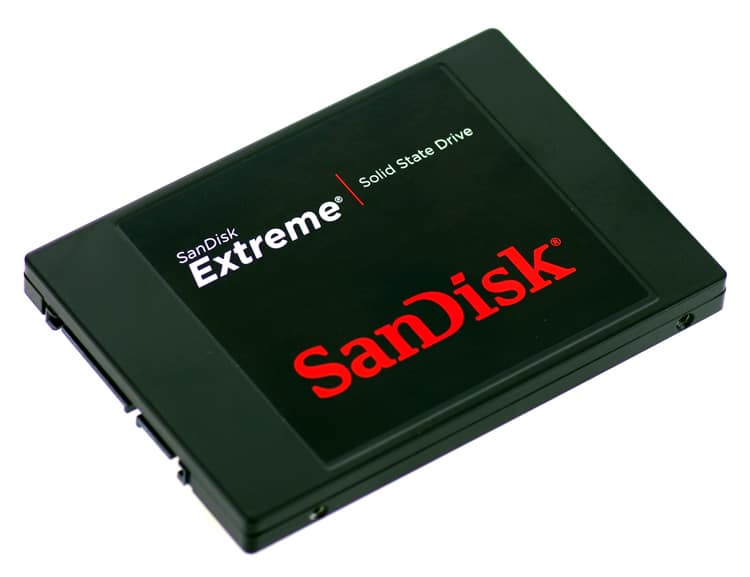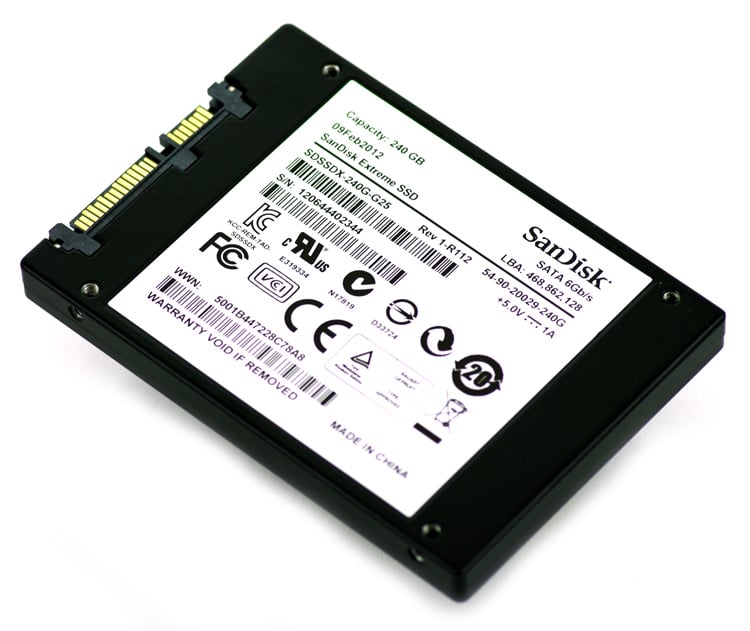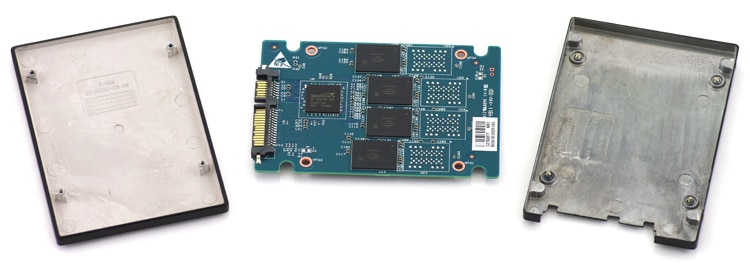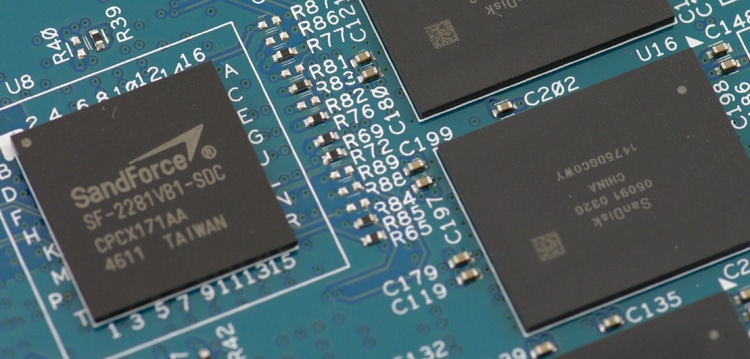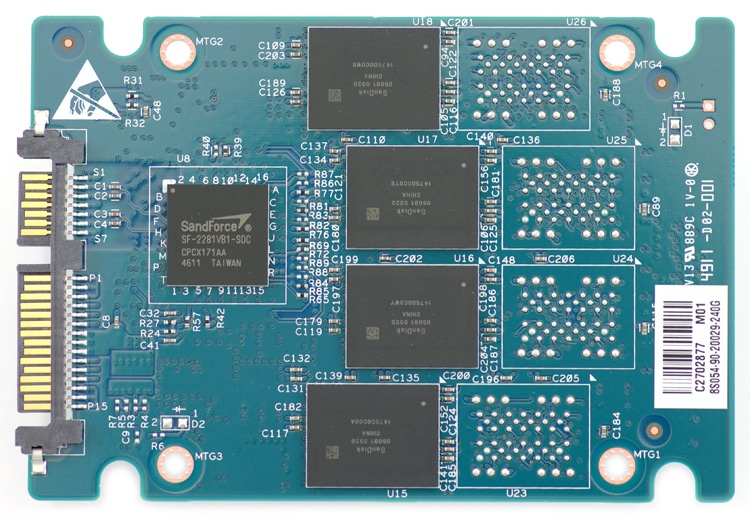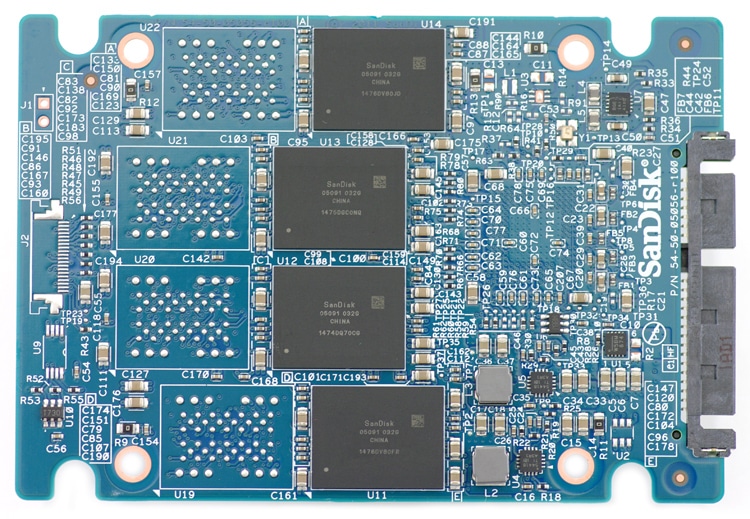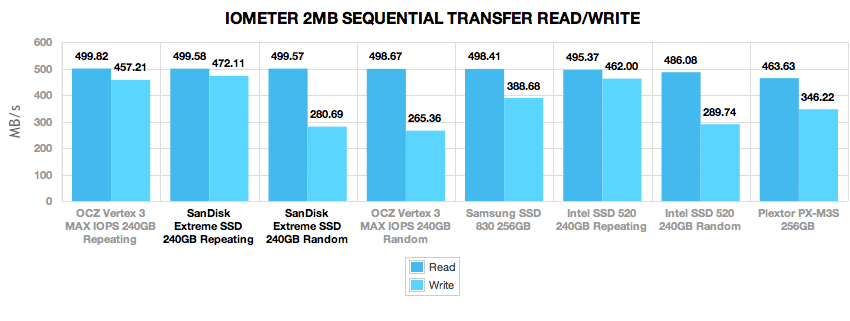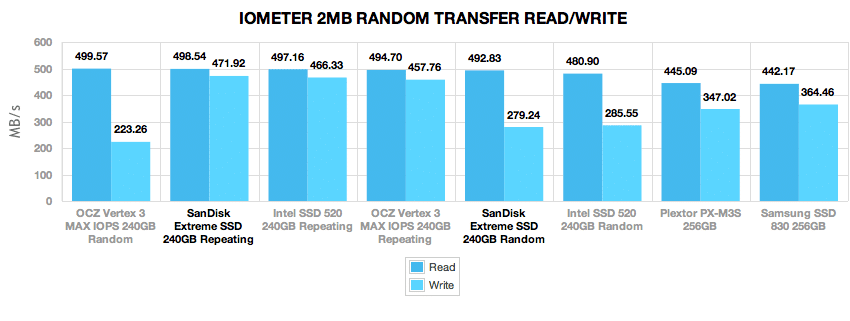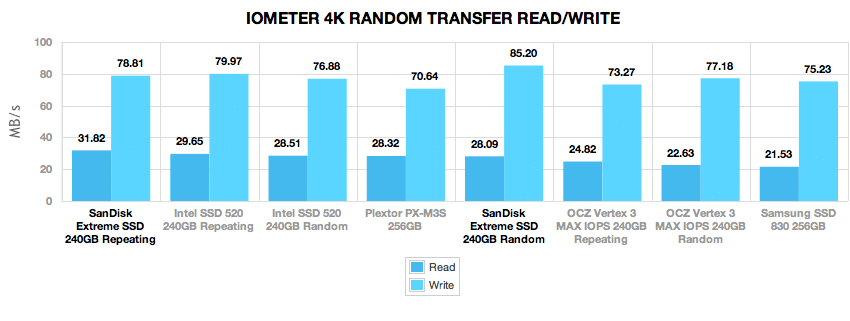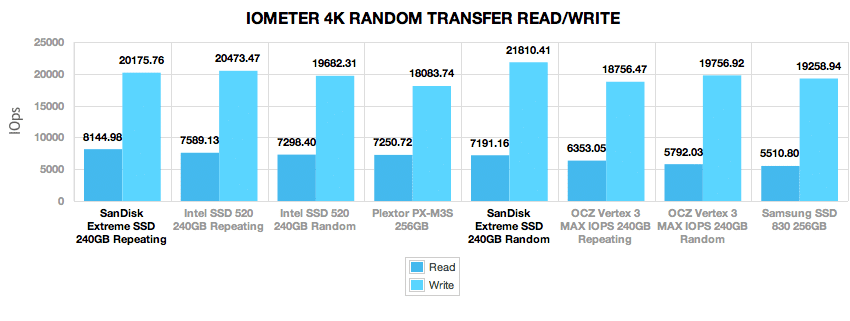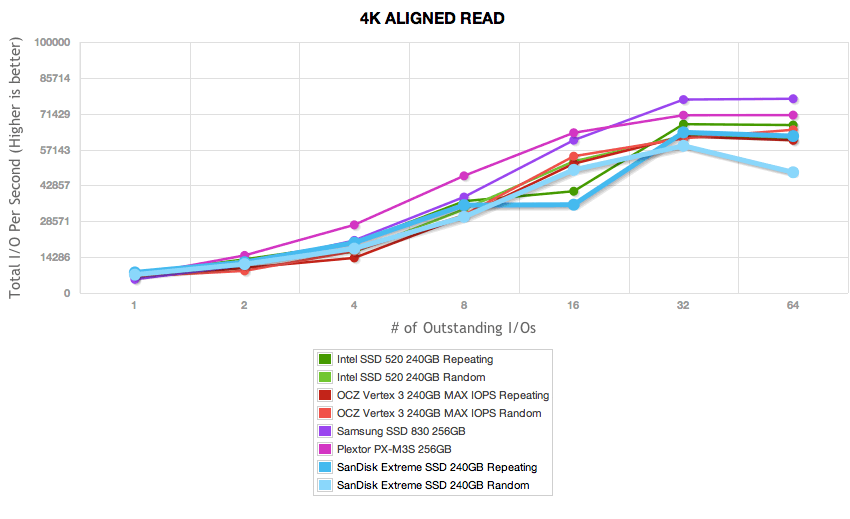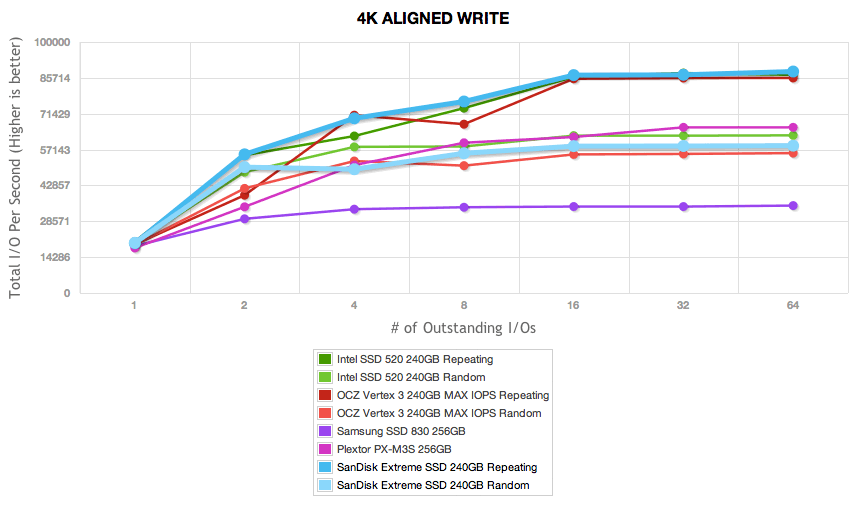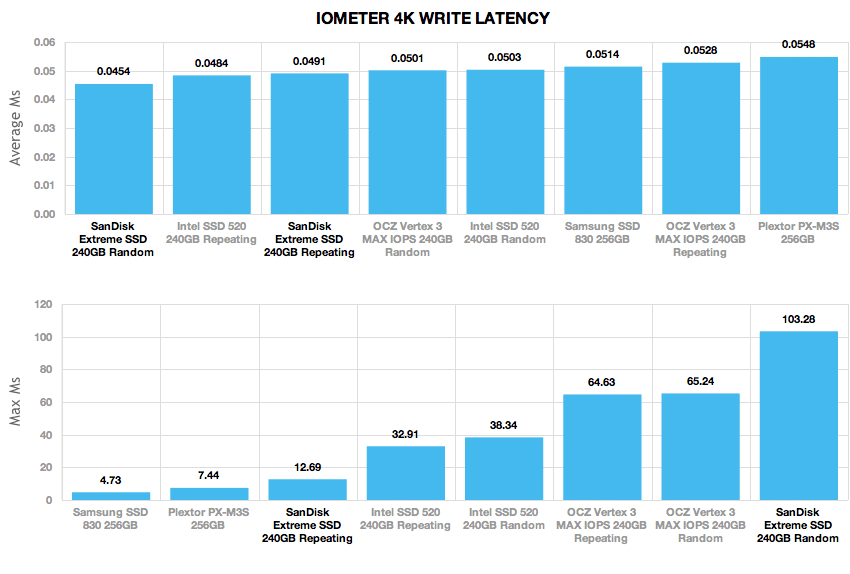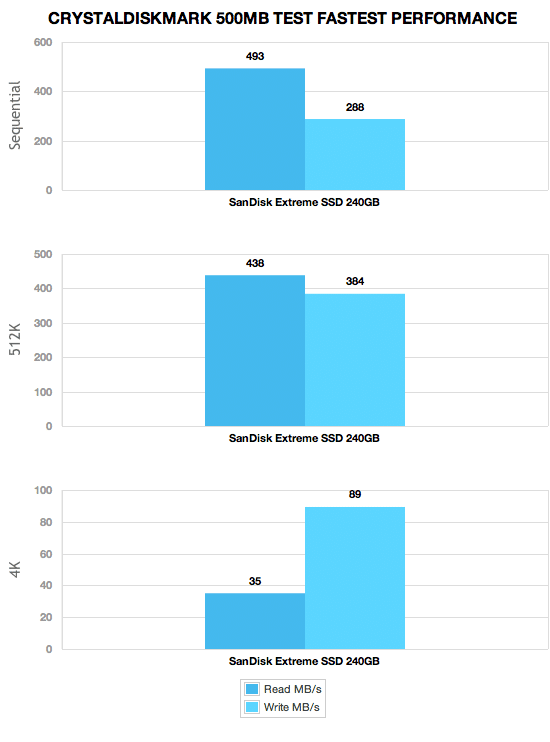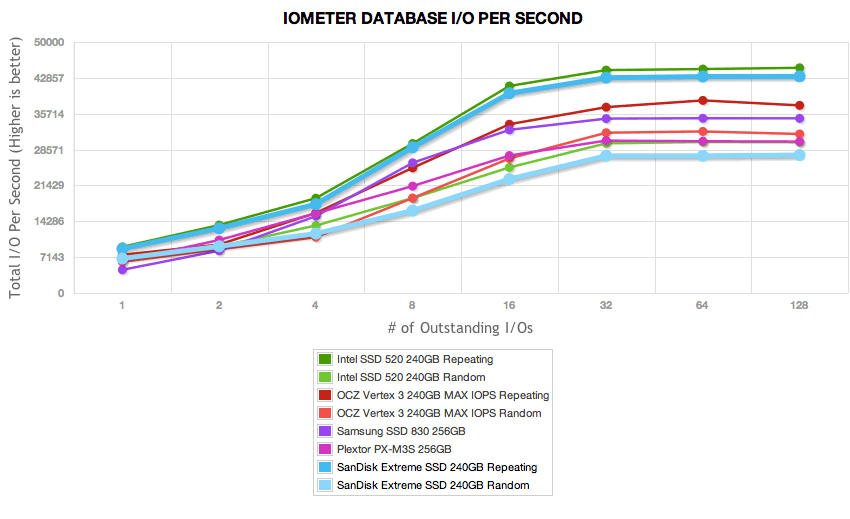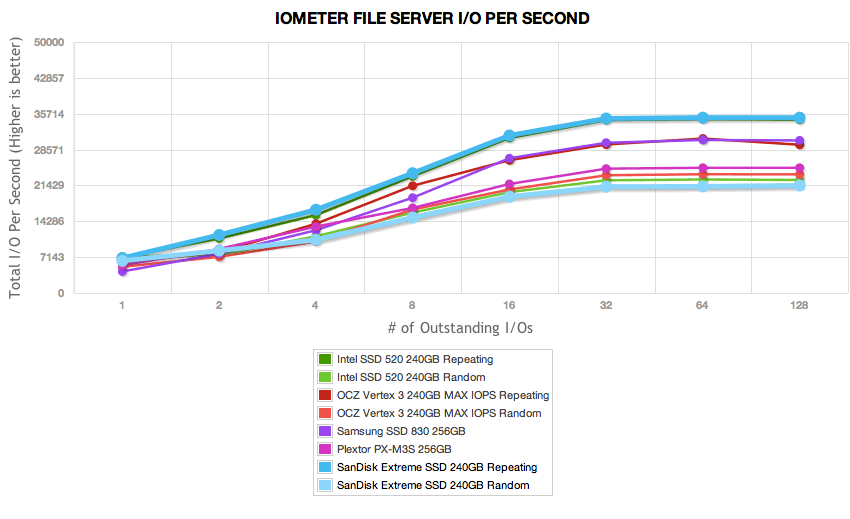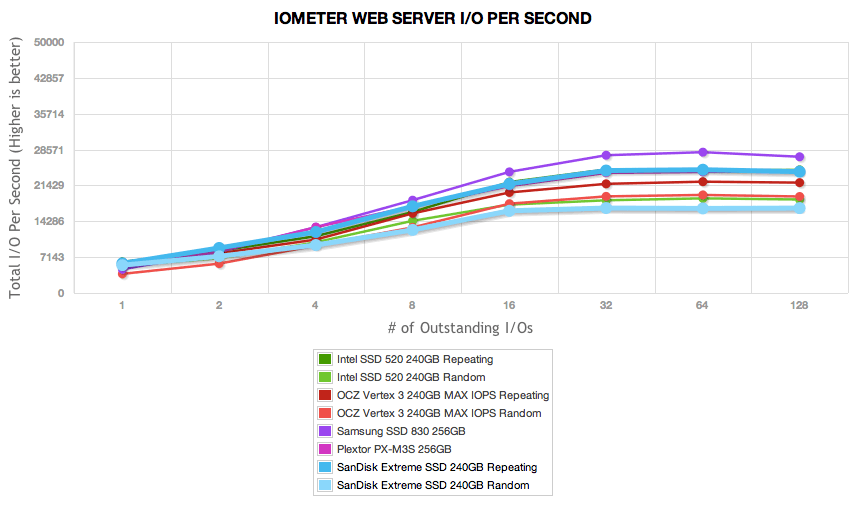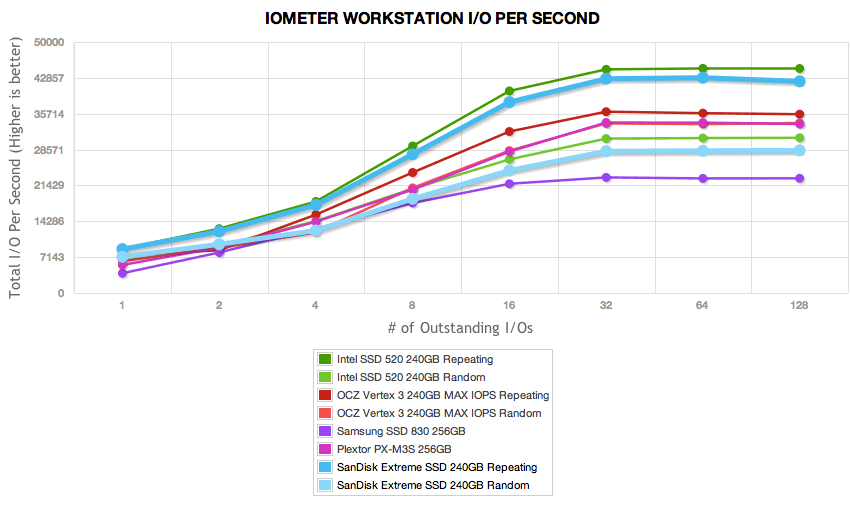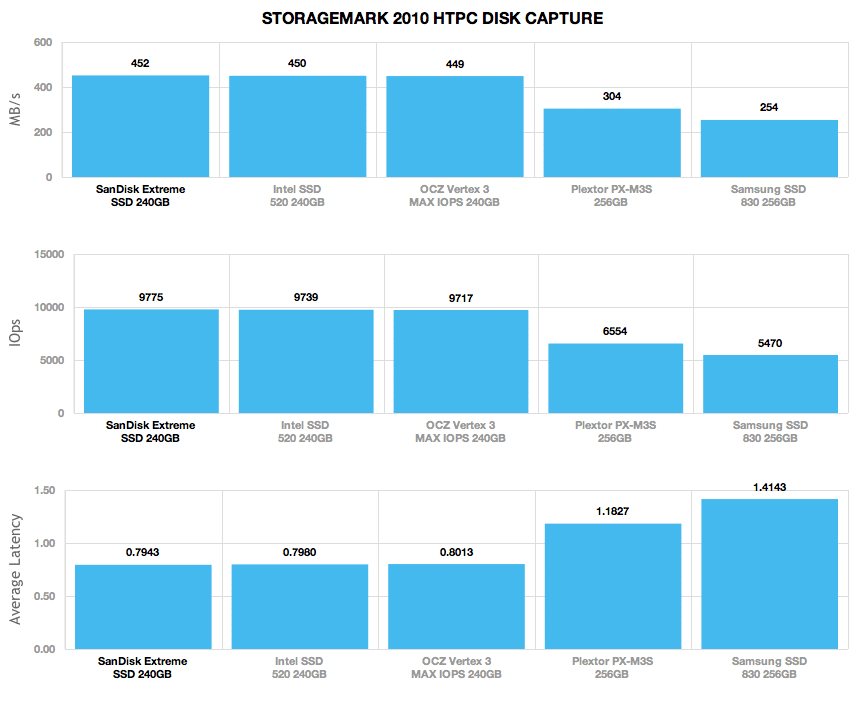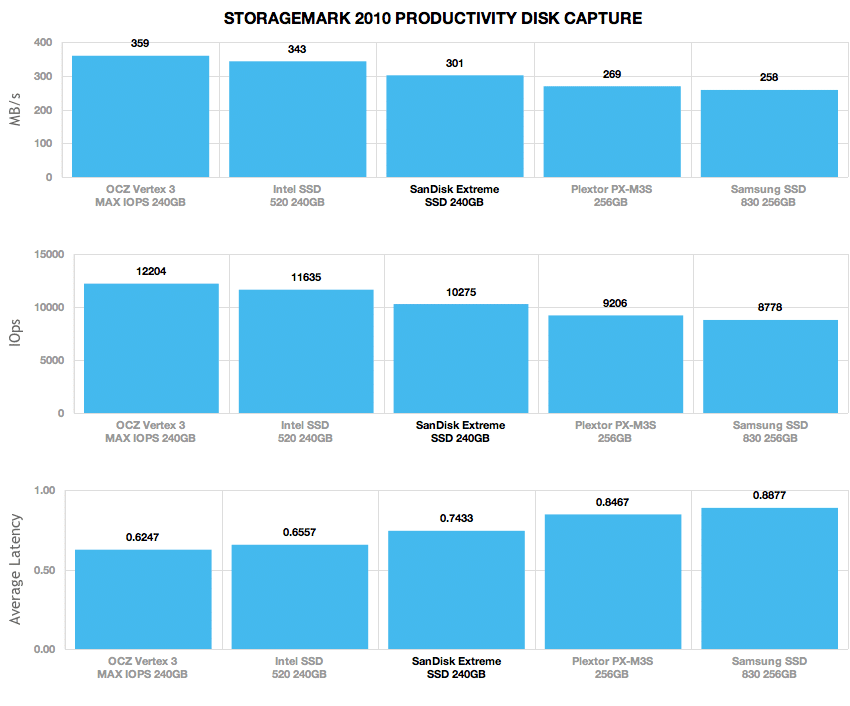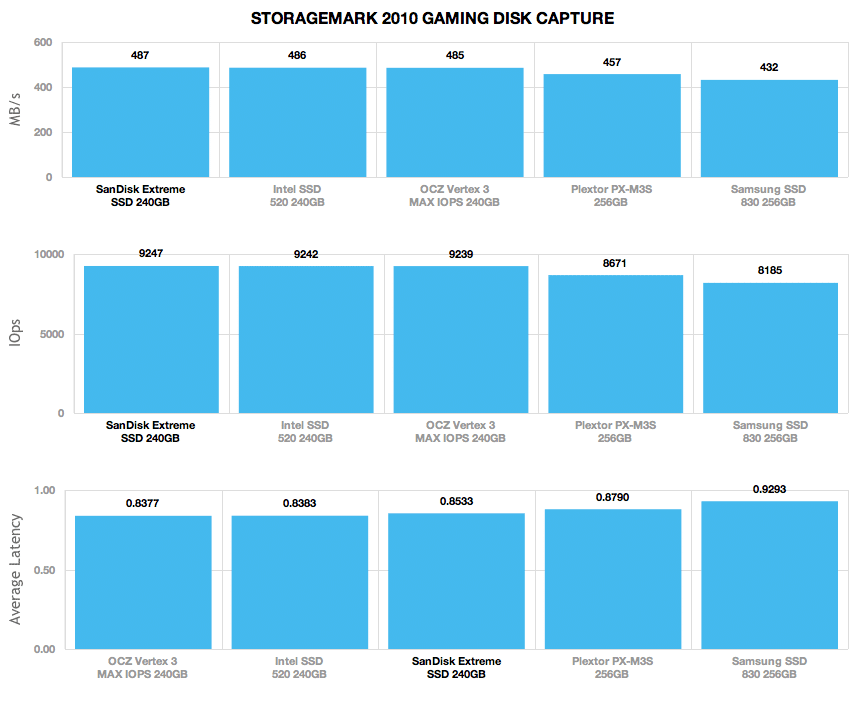
The Extreme SSD from SanDisk started when they began dipping their toe into the outward facing client SSD space at the end of last year with the Ultra SSD. The Ultra was more of a proof of concept though, while it benefited from SanDisk’s home grown NAND and engineering knowhow, it was held back by a older generation SandForce controller and SATA 3Gb/s interface. This time around, there is no such hesitation as the SanDisk Extreme SSD features the latest generation SandForce controller, SATA 6Gb/s interface and premium SanDisk MLC Toggle NAND to drive top end performance of up to 550 MB/s reads, 520MB/s writes and random write 83,000 IOPS.
The SanDisk Extreme SSD includes the best available technology for enthusiast class or performance SSDs. With SanDisk offering the latest SandForce SF-2281 processor coupled with their own 24nm Toggle NAND and custom firmware, the Extreme SSD has the potential to be the fastest SSD on the market. While the Extreme is only SanDisk’s second client SSD to be released into the retail channel recently, and many consumers may be more familiar with the SanDisk name in flash memory cards, USB drives and the like, SanDisk’s heritage in storage runs deep. With many years of client SSD experience via OEM channels and extensive DNA from their line of Lightning enterprise SAS SSDs, SanDisk has a robust flash storage pedigree.

When considering variables beyond SSD performance like endurance, compatibility and reliability, we generally find those who own key storage technologies to have an advantage. Though some SSD companies do a good job of assembling other people’s components, there’s substantial benefit when in SanDisk’s case, you have both the NAND fab and engineering knowhow that competitors don’t. Drive reliability tends to be better, but from the consumer perspective, a great advantage may be responsiveness to issues via rapid firmware updates. When evaluating an SSD, such support is important, especially in this enthusiast SSD category.
SanDisk offers the Extreme SSD in a simplified variety of 120GB, 240GB and 480GB capacities, our review unit is the mainstream 240GB model. The drives come with a three year warranty and feature a MTBF of up to 2.5 million hours. The 120GB Extreme SSD carries a street price of $169.99 while the 240GB is $339.99. The 480GB model will ship into retail in the coming months.
SanDisk Extreme SSD Specs
- Capacities
- 120GB (SDSSDX-120G-G25)
- 550 MB/s read, 510 MB/s write, 23K random read IOPS, 83K random write IOPS
- MTBF – 2.5 million hours
- Power: 0.6W Active, 1.8W Max Operating, .6W Idle, .4W Slumber
- Weight – 76g
- 240GB (SDSSDX-240G-G25)
- 550 MB/s read, 520 MB/s write, 33K random read IOPS, 83K random write IOPS
- MTBF – 2 million hours
- Power: 0.5W Active, 1.9W Max Operating, .5W Idle, .3W Slumber
- Weight – 78g
- 480GB (SDSSDX-480G-G25)
- 540 MB/s read, 460 MB/s write, 44K random read IOPS, 46K random write IOPS
- MTBF – 1.4 million hours
- Power: 0.6W Active, 2.2W Max Operating, .6W Idle, .5W Slumber
- Weight – 83g
- 120GB (SDSSDX-120G-G25)
- SATA 6 Gb/s interface
- SanDisk 24nm MLC Toggle NAND
- SandForce SF-2281
- 2.5″ 9.5mm form factor
- 3-year limited warranty
- Temperature (operating/Non-operating) – 0˚C to 70˚C / -55˚C to 95C
- Shock Resistant: 1500G @ 0.5 msec
- Vibration (operating/Non-operating) – 2.17gRMS, 5- 700Hz / 3.13gRMS, 5-800Hz
Aesthetics
The SanDisk Extreme SSD follows a red on black color scheme, which was also found on the previous generation Ultra SSD. This format both looks and feel great, especially with the all-metal body. the top of the drive features only the SanDisk branding with the model name of the drive. The label on the bottom includes important information such as the build date, capacity, part number, serial number, as well as revision number.
The Extreme SSD has a z-height of 9.5mm, which is average for SSDs in this class. Some such as the Intel SSD 520 offer a shim, which when removed, lowers the height to 7mm for use in more compact systems such as Ultrabooks.
The front of the drive has a standard SATA interface and power connection, with no outward facing service pins. All firmware updates, if issued, are handled through a software client.
Disassembly
The SanDisk Extreme SSD includes one massive warranty voiding sticker on the bottom of the SSD. The product label covers the four screw holes, featuring small Phillips-head screws used to hold the drive together. To remove the screws you must break the sticker. We don’t recommend that any buyers open their drive and risk losing the 3-year warranty SanDisk offers.
Inside the Extreme SSD we were met with the ever-popular LSI SandForce SF-2281 processor, paired up with some of SanDisk’s finest 24nm MLC Toggle NAND. To date, SanDisk is the only SandForce-powered SSD manufacturer we have seen using SanDisk NAND.
The 240GB SanDisk Extreme SSD uses an eight-piece NAND layout, with four chips located on each side of the PCB. Each MLC Toggle NAND piece is 32GB or 256Gb in density. Our guess is the 480GB model SanDisk offers uses all sixteen NAND locations.
Synthetic Benchmarks
The SanDisk Extreme SSD uses SanDisk MLC Toggle NAND, a SandForce SF-2281 processor and SATA 6Gb/s interface; our review unit is the 240GB capacity. The comparables used in this review include the following SSDs: Intel SSD 520 (240GB, SF-2281, 25nm Intel Synchronous NAND), OCZ Vertex 3 Max IOPS (240GB, SF-2281, 32nm Toshiba Toggle NAND), Plextor M3S (256GB, Marvell 9174, 2Xnm Toshiba Toggle NAND) and the Samsung SSD 830 (256GB, Samsung MCX, Samsung 2Xnm Toggle NAND). All drives are tested on the StorageReview client testing platform.
For the 240GB Extreme SSD capacity, SanDisk lists a peak read speed of 550MB/s and a write speed of 520MB/s. To put these claims to the test, we used our 2MB sequential transfer test in IOMeter.
We measured a peak transfer speed of 499.58MB/s read and 472.11MB/s write with compressible data, which dropped to 499.57MB/s read and 280.69MB/s write with incompressible or randomized data.
Our next test looks at random 2MB transfers instead of sequential, showing what performance might look like during multiple file transfer requests.
In our large-block random transfer test the SanDisk Extreme SSD maintained a quick transfer speed of 498.54MB/s read and 471.92MB/s write with compressible data lowering to 492.83MB/s read and 279.24MB/s write with incompressible data.
Moving on to even smaller transfer request sizes, our next section looks at random 4K read and write performance at a queue depth of one, and later moves to expanded queue depth tests.
We were rather surprised by how strong the 4K read speeds were on the SanDisk Extreme SSD at a low queue depth. Measuring 8,144 IOPS, it came in 7% faster than the Intel SSD 520 and led the pack. It also offered the highest low-queue depth 4K random write speeds, measuring 21,810 IOPS with incompressible data.
In our expanded 4K random read and write tests, we look how well each drive performed with multithreaded access.
At higher queue depths the SanDisk Extreme SSD, as well as other SandForce-powered models were outpaced by the Samsung and Marvell-powered Samsung SSD 830 and Plextor M3S SSDs.
In the 4K random write test the SanDisk Extreme SSD maintained its strong lead into the higher queue depths, topping out with a speed of 88,234 IOPS at a queue depth of 64.
In our 4K write latency test, which measures access times at a queue depth of 1, the SanDisk Extreme SSD scored excellent with chart topping response times of 0.0454ms with incompressible data and 0.0491ms with compressible data. Peak latency times were also great, measuring 12.69ms and 103.28ms for repeating and randomized respectively.
Using CrystalDiskMark with randomized data, we noted similar read and write speeds as what we found with our incompressible IOMeter testing, although CDM did show slightly higher 4K random read figures.
Our last group of consumer IOMeter synthetic benchmarks looks at mixed-load server profiles including Database, Workstation, File Server, and Webserver. In a mixed workload environment the SanDisk Extreme SSD traded spots at the top of the charts with both the Intel SSD 520 and Samsung SSD 830.
Real-World Benchmarks
One thing we try to focus on with our reviews is how any given drive might perform under real-world conditions. For the average user, trying to translate random 4K write speeds into an everyday situation can be difficult. It helps when comparing drives in every setting possible, but it doesn’t exactly work out into faster everyday usage or better game loading times. For this reason we turned to our StorageMark 2010 traces, which include HTPC, Productivity, and Gaming traces to help readers find out how a drive might rank under their conditions.
The first real-life test is our HTPC scenario. In this test we include: playing one 720P HD movie in Media Player Classic, one 480P SD movie playing in VLC, three movies downloading simultaneously through iTunes, and one 1080i HDTV stream being recorded through Windows Media Center over a 15 minute period. Higher IOps and MB/s rates with lower latency times are preferred. In this trace we recorded 2,986MB being written to the drive and 1,924MB being read.
In our first trace covering an HTPC profile, the SanDisk Extreme SSD topped the charts with a lead of 2MB/s over the Intel SSD 520.
Our second real-life test covers disk activity in a productivity scenario. For all intents and purposes this test shows drive performance under normal daily activity for most users. This test includes: a three hour period operating in an office productivity environment with 32-bit Vista running Outlook 2007 connected to an Exchange server, web browsing using Chrome and IE8, editing files within Office 2007, viewing PDFs in Adobe Reader, and an hour of local music playback with two hours of additional online music via Pandora. In this trace we recorded 4,830MB being written to the drive and 2,758MB being read.
In our Productivity trace with a higher mix of random access and write-based workloads, the SanDisk Extreme slipped, coming in with a speed of 301MB/s compared to 359MB/s from the Intel SSD 520.
Our third real-life test covers disk activity in a gaming environment. Unlike the HTPC or Productivity trace, this one relies heavily on the read performance of a drive. To give a simple breakdown of read/write percentages, the HTPC test is 64% write, 36% read, the Productivity test is 59% write and 41% read, while the gaming trace is 6% write and 94% read. The test consists of a Windows 7 Ultimate 64-bit system pre-configured with Steam, with Grand Theft Auto 4, Left 4 Dead 2, and Mass Effect 2 already downloaded and installed. The trace captures the heavy read activity of each game loading from the start, as well as textures as the game progresses. In this trace we recorded 426MB being written to the drive and 7,235MB being read.
In our Gaming trace the SanDisk Extreme SSD came in with the highest speed, measuring 487MB/s average. With this faster speed though, it had a higher average response time measuring 0.85ms compared to 0.84ms from the Intel SSD 520 or OCZ Vertex 3 MAX IOPS.
Power
Applying the same read and write profiles that we performed at the beginning of this review, we measure the power used by the SSD during these read or write profiles. SandForce SSDs heavily rely on compression for faster speeds and less write amplification, as a result we measure power with both compressible and incompressible data.
SanDisk lists an average operating power value of 0.6 watts, a peak of 2.2 watts, and an idle of 0.6 watts. In our tests we measured read and write behavior between 1.93 watts and 1.45 watts with constant activity. Random 2MB sequential write with incompressible data peaked at 4.10 watts, with startup requirements measuring 3.22 watts.
Conclusion
The SanDisk Extreme SSD is surprising in a many ways. Just when we thought we had seen the top of what the SF-2281 SSDs are capable of, SanDisk unleashes the Extreme SSD with a unique NAND configuration and firmware that delivered impressive numbers. The results in several areas are astounding, with 4K random write speeds topping 88,324 IOPS and the Extreme posted the top scores in our HTPC and Gaming real world benchmarks, if only by a hair. What really knocked our socks off though are the 4K QD1 random reads of 8,144 IOPS, beating the Intel SSD 520 by 7% and the OCZ Vertex 3 MAX IOPS by 28%. This is largely thanks to SanDisk’s own MLC Toggle NAND.
The Extreme SSD also accomplishes another major feat – price. Historically new entrants to the SSD space hold prices high, until enough volume and distribution drives costs down. SanDisk skipped that entire dance, coming to the street with prices that are substantially lower than the Intel SSD 520 and Vertex 3 Max IOPS.
Overall we were very impressed by the performance of the SanDisk Extreme SSD. It didn’t offer the fastest performance in every category, but it was able to snag the top spot in plenty of our tests. To come in with that level of performance just as the SandForce market was starting mature is impressive to say the least.
Pros
- Extremely fast low-queue depth 4K random read speeds
- Chart topping 4K random write speeds measuring 88,324 IOPS
- Very competitive pricing
Cons
- Showed some weakness in our mixed-workload server profiles and StorageMark Productivity trace
Bottom Line
The SanDisk Extreme SSD boasts some of the fastest speeds we have recorded for a client SSD, with exceptionally strong 4K random read and random write speeds. SanDisk delivers a mighty trifecta to consumers with the Extreme SSD – class leading performance, support and pricing.
SanDisk Extreme SSD at Amazon.com

